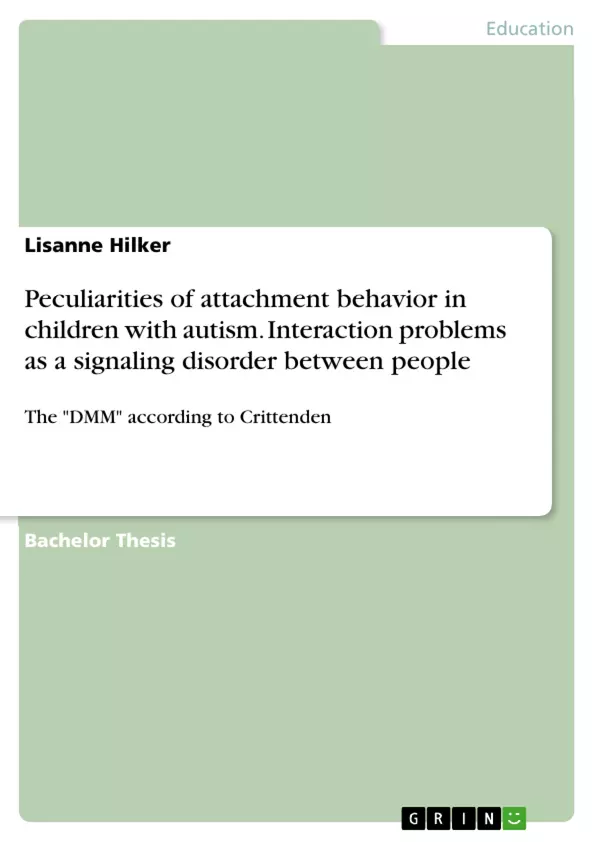The phenomenon of autism seems to fascinate society as it becomes more widely known, but unfortunately its significance is often completely misunderstood. Reactions to the topic are often monosyllabic. Along with the symptoms come interesting ideas: people with autistic disability live in their "own world," they have no feelings or social interest, and they are also geniuses. This work is concerned, among other things, with clearing up these false "facts".
The main part of this thesis can be divided into three parts: first the topic of autism is dealt with, then that of attachment and finally attachment behavior in people with autism. This bachelor thesis does not only serve to enlighten about autism, i.e. to describe the development of autism research and the symptomatology, but also to dedicate a special aspect: the assumption that people with autistic disabilities have no social interest and do not develop emotions.
In order to examine this aspect more closely, the time of early childhood will be addressed, the age at which the person forms his first attachments. It will be attempted to get to the bottom of the cause and purpose of attachment, the theory of attachment, the phases and forms that attachment goes through and takes on, as well as which factors promote stable attachment behavior.
However, the questions that this bachelor thesis ultimately addresses are: Can all people form attachments in principle? If so, how do they manifest themselves in disabled children, especially in children with autistic disabilities? Are there any special features and if so, what are they due to? A special role in answering these questions will be played by the "Dynamic Maturation Model of Attachment and Adaptation" according to Dr. Patricia Crittenden.
Table of Contents
- 1. Introduction
- 2. Autism
- 2.1. The pioneers of autism research
- 2.1.1. Hans Asperger
- 2.1.2. Leo Kanner
- 2.2. Autism today - the symptomatology
- 2.3. Perceptual peculiarities
- 2.3.1. Seeing
- 2.3.2. Listening
- 2.1. The pioneers of autism research
- 3. First binding
- 3.1. The bonding theory according to John Bowlby
- 3.2. The \"Foreign Situation\" according to Ainsworth and Wittig
- 3.2.1. The 4 binding types
- 3.2.2. Cause and purpose of the development of a binding system
- 3.2.3. Attachment behaviour in disabled children
- 3.2.3.1. Resilience and vulnerability in children at risk
- 3.2.4. Mother-child bonding in interaction with a disabled child
- 3.3. Initial conclusions
- 4. Autistics and attachment - explained at the \"DMM\" according to Crittenden
- 4.1. Definition of the DMM
- 4.2. Autistic children and \"signal disturbances\" of negative base effects
- 4.3. Resulting interaction in mother and child
- 5. Conclusion
Objectives and Key Themes
This Bachelor's thesis aims to educate on autism, including the development of autism research and the symptoms. It specifically examines the assumption that people with autistic disabilities lack social interest and emotional development. To delve into this aspect, the thesis focuses on early childhood, the period in which individuals form their first bonds.
- Exploring the historical development of autism research and the understanding of autistic behavior
- Analyzing the diverse symptoms and challenges experienced by individuals with autism
- Investigating the concept of attachment theory and its application to children with autistic disabilities
- Examining the “Dynamic Maturation Model of Attachment and Adaptation” by Dr. Patricia Crittenden and its implications for understanding attachment behaviors in autistic individuals
- Addressing the misconception that individuals with autism lack social interest and emotional capacity
Chapter Summaries
- Chapter 1: Introduction This chapter begins by introducing the concept of autism and its often misunderstood portrayal in society. It highlights the prevalence of autism and the common misconceptions surrounding its symptoms. The chapter sets the stage for the thesis by outlining its main objectives and the key themes it will explore.
- Chapter 2: Autism This chapter delves into the history of autism research, tracing its origins and development. It introduces the contributions of key pioneers like Hans Asperger and Leo Kanner and discusses the evolution of understanding autistic behavior. The chapter provides a detailed overview of the symptomatology of autism and explores the specific perceptual peculiarities associated with the condition. It focuses on how individuals with autism experience and process visual and auditory information.
- Chapter 3: First Binding This chapter examines the fundamental concept of attachment theory as developed by John Bowlby. It explores the different attachment styles and how they develop in early childhood. The chapter then delves into the complexities of attachment in the context of disabled children, particularly those with autism. It examines factors that contribute to resilience and vulnerability in children at risk and investigates the dynamics of mother-child bonding when the child has a disability.
- Chapter 4: Autistics and Attachment - Explained at the “DMM” according to Crittenden This chapter introduces the “Dynamic Maturation Model of Attachment and Adaptation” (DMM) by Dr. Patricia Crittenden. The chapter explains the model and its application to understanding attachment behaviors in autistic individuals. It examines how autistic children may experience “signal disturbances” and how these disturbances influence their interactions with others, particularly their caregivers. The chapter explores the resulting interaction patterns between mothers and autistic children.
Keywords
The main focus of this work revolves around the understanding and complexities of autism. Key themes include autism spectrum disorders, attachment theory, early childhood development, interaction problems, social communication, and the “Dynamic Maturation Model of Attachment and Adaptation” (DMM) by Dr. Patricia Crittenden. The work delves into the impact of autism on social interaction, emotional development, and the formation of early bonds, particularly exploring how autistic individuals may perceive and interpret social cues.
- Citar trabajo
- Lisanne Hilker (Autor), 2014, Peculiarities of attachment behavior in children with autism. Interaction problems as a signaling disorder between people, Múnich, GRIN Verlag, https://www.grin.com/document/1175609



